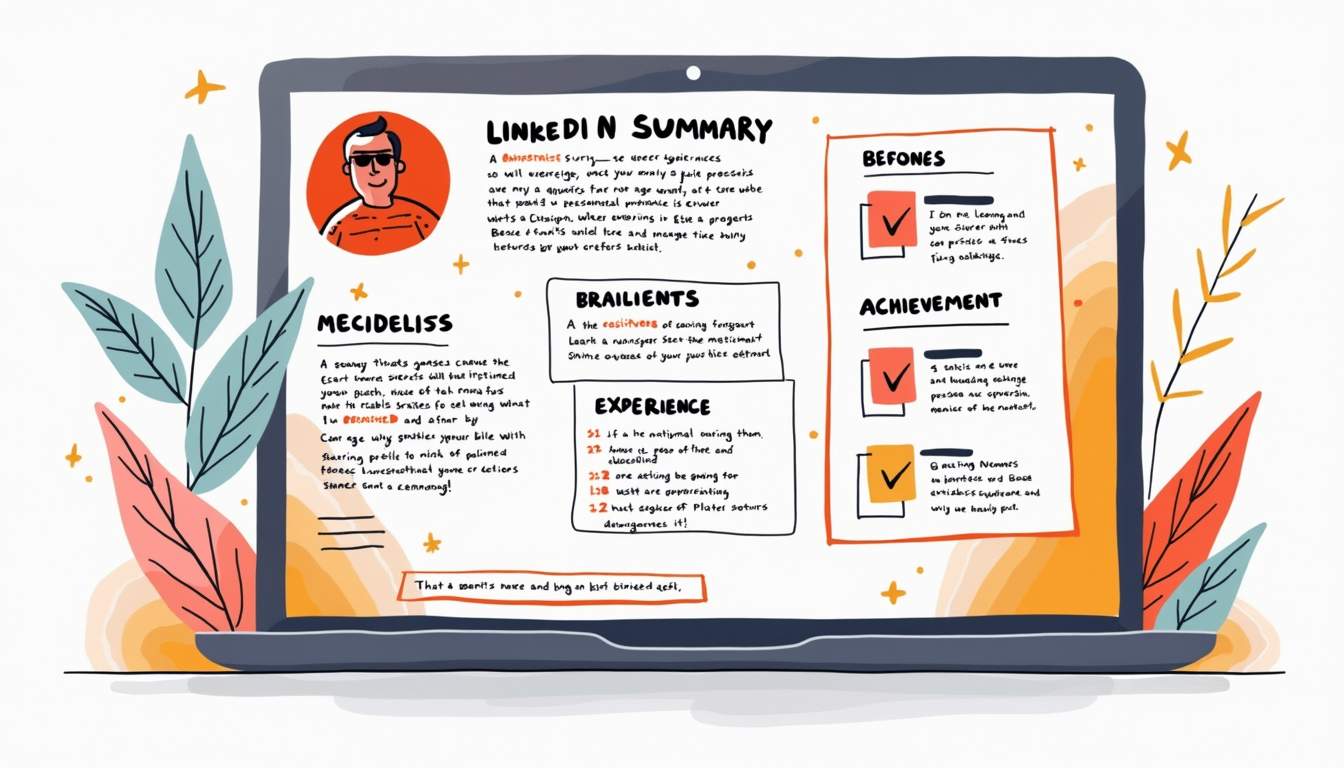“`html
In today’s digital age, having a strong LinkedIn profile is crucial for professionals looking to make meaningful connections, showcase their skills, and advance their careers. With millions of users on the platform, standing out is essential. Here are ten essential tips to help you optimise your LinkedIn profile for maximum impact.
Professional Profile Photo
Your profile photo is often the first impression you make on potential connections, recruiters, and employers. A professional image can significantly enhance your profile’s credibility. Choose a high-resolution photo where you are dressed appropriately for your industry. Ensure that your face is clearly visible, and avoid distracting backgrounds.

Additionally, consider the expression you convey through your photo. A friendly smile can make you appear approachable and open to networking opportunities. Remember, your profile photo should reflect your professional persona while still being authentic to who you are.
Choosing the Right Background
The background of your profile photo can also play a role in how you are perceived. Opt for a neutral or simple background that does not detract from your face. If you want to add a personal touch, consider a setting that reflects your profession or interests, but ensure it remains professional.
Updating Your Photo Regularly
As your career progresses, so should your profile photo. Regularly updating your image can reflect your current professional status and keep your profile fresh. A good rule of thumb is to refresh your photo every couple of years or after significant career milestones.
Compelling Headline
Your LinkedIn headline is one of the most visible parts of your profile. It appears right beneath your name and is crucial for making a strong first impression. Instead of simply listing your job title, use this space to highlight your unique value proposition. Consider including your key skills, industry, and what you bring to the table.
For example, instead of stating “Marketing Manager,” you might say “Results-Driven Marketing Manager Specialising in Digital Strategies and Brand Growth.” This approach not only informs viewers of your current role but also showcases your expertise and focus areas.
Incorporating Keywords
Using relevant keywords in your headline can enhance your profile’s visibility in search results. Think about the terms that potential employers or connections might use when looking for someone with your skills. Incorporate these keywords naturally into your headline to increase your chances of being discovered.
Reflecting Your Career Goals
Your headline can also reflect your career aspirations. If you are looking to transition into a new field, consider including that in your headline. For instance, “Aspiring Data Analyst with a Passion for Data-Driven Decision Making.” This signals to others your interests and goals, potentially opening doors for opportunities in that area.
Detailed Summary
The summary section of your LinkedIn profile is your chance to tell your professional story. Use this space to elaborate on your career journey, skills, and what you are passionate about. A well-crafted summary can engage readers and encourage them to connect with you.

Start with a strong opening statement that captures your professional identity. Follow this with a brief overview of your experience, highlighting key achievements and skills. Don’t shy away from showcasing your personality; a touch of authenticity can make your summary more relatable.
Structuring Your Summary
Consider using bullet points or short paragraphs to make your summary easy to read. Break down your skills, accomplishments, and career highlights into digestible sections. This format allows readers to quickly grasp your qualifications and expertise.
Including a Call to Action
At the end of your summary, consider including a call to action. This could be an invitation to connect, collaborate, or discuss opportunities. A simple statement like “Feel free to reach out if you’d like to connect or discuss potential collaborations!” can encourage engagement and networking.
Showcase Skills
LinkedIn allows you to list your skills, which can be endorsed by your connections. This feature is essential for demonstrating your expertise and credibility. Be strategic in selecting the skills you want to showcase, focusing on those most relevant to your career goals and industry.
Consider including a mix of hard skills (technical abilities) and soft skills (interpersonal abilities). This combination provides a well-rounded view of your capabilities. Additionally, regularly update your skills to reflect your evolving expertise and interests.
Prioritising Your Skills
LinkedIn allows you to reorder your skills based on importance. Place the most relevant skills at the top of the list to ensure they catch the attention of viewers. This prioritisation can influence how others perceive your strengths and areas of expertise.
Encouraging Endorsements
Encourage your connections to endorse your skills. A higher number of endorsements can enhance your credibility and make your profile more attractive to potential employers. You can initiate this by endorsing others, as they may reciprocate the gesture.
Custom URL
Having a custom LinkedIn URL can make your profile easier to share and more professional. Instead of the default URL filled with numbers and letters, you can create a clean, memorable link that includes your name or a variation of it. This small change can enhance your personal branding.
To create a custom URL, navigate to your profile settings and look for the option to edit your public profile URL. Choose a format that is easy to remember and reflects your professional identity. This URL can be included on your resume, business cards, and other professional materials.
Benefits of a Custom URL
A custom URL not only looks more professional but also improves your searchability. When someone searches for your name, a clean URL can help ensure that your LinkedIn profile appears at the top of the results. This is particularly beneficial for job seekers and professionals looking to establish their online presence.
Consistency Across Platforms
Consider using the same custom URL across different platforms, such as your personal website or other social media profiles. Consistency in your online branding can help reinforce your professional identity and make it easier for others to find you.
Engaging Experience Section
Your experience section is a critical component of your LinkedIn profile. It provides an opportunity to showcase your work history, responsibilities, and achievements. When detailing your experience, focus on quantifiable results and specific contributions you made in each role.
Use action verbs to describe your responsibilities and accomplishments. Instead of saying “Responsible for managing a team,” you might say “Led a team of five to achieve a 20% increase in sales within six months.” This approach not only highlights your role but also demonstrates your impact.
Highlighting Key Achievements
In addition to listing your duties, make sure to highlight key achievements in each position. This could include awards, recognitions, or successful projects. Use bullet points for clarity and to draw attention to your most significant contributions.
Tailoring Your Experience
Consider tailoring your experience section to align with your career goals. If you are looking to transition into a new field, emphasise transferable skills and relevant experiences that showcase your suitability for that industry. This targeted approach can make your profile more appealing to potential employers.
Recommendations and Endorsements
Recommendations from colleagues, supervisors, or clients can add significant weight to your LinkedIn profile. They provide social proof of your skills and work ethic, making you more attractive to potential employers. Reach out to individuals who can speak positively about your contributions and ask them to write a recommendation for you.
When requesting recommendations, be specific about what you would like them to highlight. This could be a particular project you worked on together or a skill you demonstrated. Providing context can help your connections write more meaningful and relevant recommendations.
Endorsements for Skills
In addition to recommendations, endorsements for your skills can enhance your profile’s credibility. Encourage your connections to endorse your skills by endorsing theirs in return. This reciprocal approach can help build a network of support and validation for your abilities.
Regularly Updating Recommendations
As you progress in your career, consider updating your recommendations to reflect your latest achievements and roles. This ensures that your profile remains current and accurately represents your professional journey. Regular updates can also prompt your connections to revisit your profile and engage with your content.
Active Networking
Networking is one of the primary purposes of LinkedIn. Actively engaging with your connections can help you build relationships and expand your professional network. Start by connecting with colleagues, industry peers, and alumni. Personalise your connection requests to increase the likelihood of acceptance.
Once connected, engage with your network by liking, commenting, and sharing their posts. This not only keeps you visible but also fosters a sense of community. Building genuine relationships can lead to valuable opportunities, referrals, and collaborations.
Utilising LinkedIn Messaging
Don’t hesitate to use LinkedIn’s messaging feature to reach out to connections. Whether it’s to catch up, ask for advice, or discuss potential collaborations, a thoughtful message can strengthen your professional relationships. Be respectful of their time and keep your messages concise and relevant.
Attending LinkedIn Events
LinkedIn often hosts virtual events and webinars that can be valuable for networking. Attend these events to meet new people in your industry and learn from experts. Engaging in discussions during these events can lead to meaningful connections and insights.
Regular Content Sharing
Sharing content on LinkedIn can position you as a thought leader in your industry. Regularly post articles, insights, or updates related to your field. This not only keeps your profile active but also provides value to your connections. Aim to share a mix of original content and curated articles that resonate with your audience.

When sharing content, consider adding your perspective or insights. This personal touch can encourage engagement and spark discussions. Additionally, use relevant hashtags to increase the visibility of your posts and reach a broader audience.
Engaging with Others’ Content
In addition to sharing your own content, engage with posts from your connections and industry leaders. Commenting thoughtfully on others’ posts can help you build relationships and establish your presence in your field. This reciprocal engagement can lead to increased visibility for your profile.
Creating a Content Calendar
To maintain consistency in your content sharing, consider creating a content calendar. Plan out topics, types of content, and posting schedules. This proactive approach can help you stay organised and ensure that you are regularly contributing to the LinkedIn community.
Join Relevant Groups
LinkedIn groups provide a platform for professionals with similar interests to connect, share insights, and discuss industry trends. Joining relevant groups can expand your network and expose you to new ideas and opportunities. Look for groups that align with your career goals and interests.
Once you join a group, actively participate in discussions. Share your insights, ask questions, and engage with other members. This involvement can help you establish yourself as a knowledgeable resource within the group and foster connections with like-minded professionals.
Networking Opportunities in Groups
Groups can also serve as valuable networking opportunities. Connect with group members who share your interests or career goals. Building relationships within these groups can lead to collaborations, mentorship, and job opportunities.
Staying Updated on Industry Trends
Participating in groups allows you to stay informed about the latest trends and developments in your industry. Engaging with discussions and sharing relevant articles can enhance your knowledge and position you as an informed professional. This ongoing learning can be beneficial for your career growth.
By implementing these ten essential tips, you can optimise your LinkedIn profile for maximum impact. A well-crafted profile not only enhances your online presence but also opens doors to new opportunities and connections. Take the time to invest in your LinkedIn profile, and watch as it transforms into a powerful tool for your professional journey.
“`